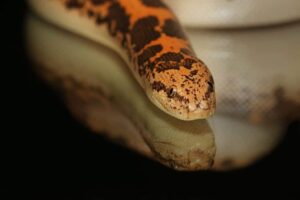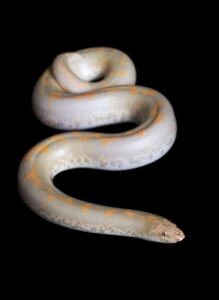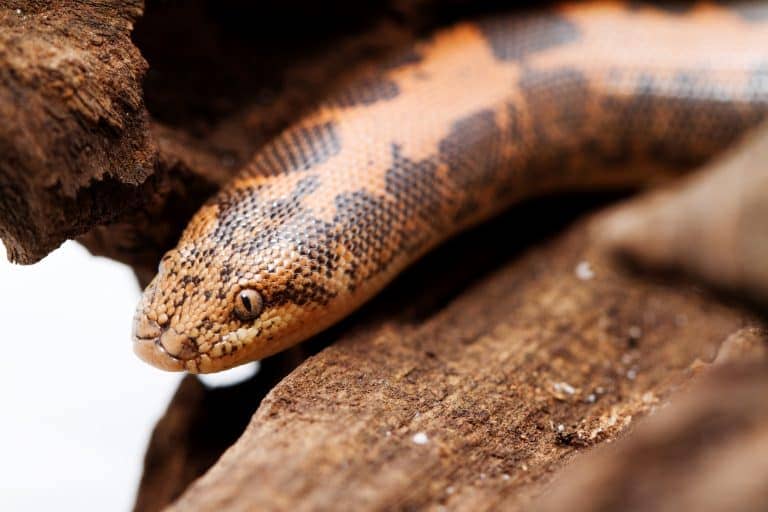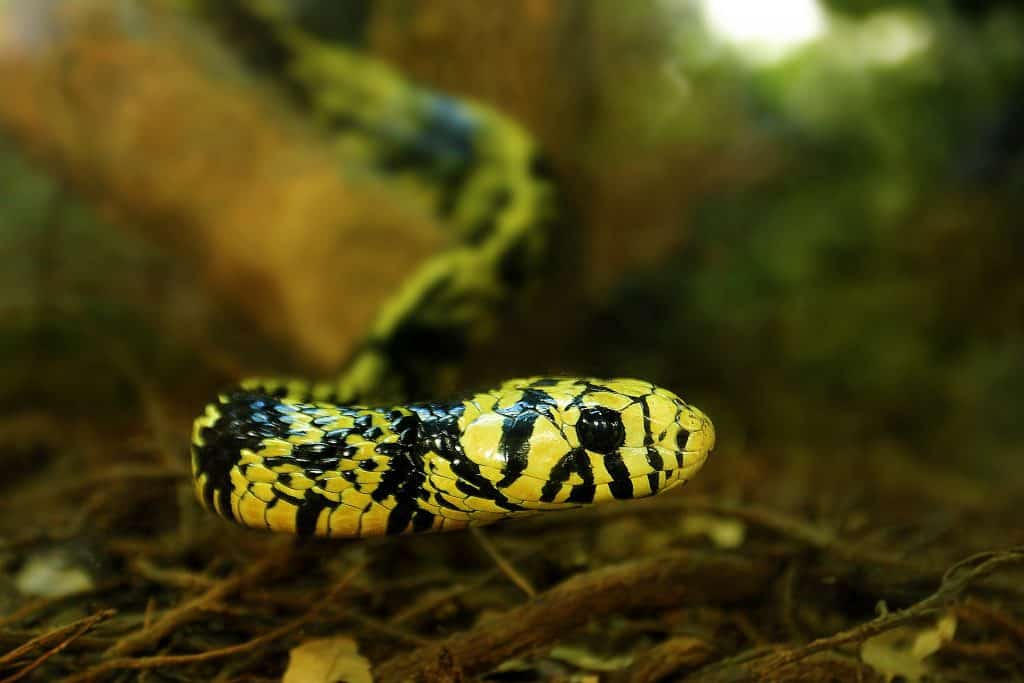Introduction to the Kenyan Sand Boa
Meet one of the most charming and beginner-friendly snakes in the reptile world—the Kenyan Sand Boa. This little noodle of a snake has won over herpers (snake lovers) around the world with its low-maintenance lifestyle, compact size, and docile nature.
What Makes Them Unique?
Kenyan Sand Boas (Eryx colubrinus) are fossorial, meaning they love to burrow and spend most of their time hiding under sand or loose substrate. Their stout, cylindrical bodies and blunt heads are perfectly designed for life underground. Plus, their striking orange-and-brown coloration is eye-catching and unique.
Quick Overview of Their Natural Habitat
In the wild, these snakes are native to northeastern Africa—found in arid areas of Kenya, Egypt, Ethiopia, and surrounding regions. They’re adapted to hot, dry climates with sandy or loose soil perfect for burrowing.

Why Choose a Kenyan Sand Boa as a Pet?
Personality and Temperament
Kenyan Sand Boas are incredibly chill. They’re not aggressive and usually tolerate handling well, especially when you respect their need for burrowing and hiding. They’re solitary and not overly active, so they won’t stress easily if left alone for a while.
Ideal for Beginners
These snakes don’t require any fancy tech or enormous tanks, and they eat like champs (most of the time). They’re also not prone to biting, making them great for people new to snake ownership.
Kenyan Sand Boa Appearance
Size and Color Morphs
A fully grown male Kenyan Sand Boa typically reaches 15–18 inches, while females can get up to 2–3 feet. As for color? The classic morph is orange with brown splotches, but breeders have created a rainbow of morphs like albino, anerythristic, snow, and paradox.
Differences Between Males and Females
Aside from the size difference, males tend to be slimmer and have longer tails. If you’re interested in breeding, this is key for identifying your snake’s sex.
Setting Up the Perfect Enclosure
Tank Size Requirements
For one adult, a 10–20 gallon tank is plenty. Babies can live comfortably in even smaller setups, like a 5-gallon container. These snakes don’t need vertical space, so floor area is what matters most.
Best Substrate Options
Loose, dry substrate is a must. Aspen shavings, coconut husk, or even a mix of play sand and soil (baked for safety) work great. Avoid pine or cedar—they’re toxic.
Temperature and Humidity Needs
-
Basking Spot: 90–95°F
-
Cool Side: 75–80°F
-
Humidity: Low, around 30–40%
Use a heat mat with a thermostat, and skip the humidity boosts unless your snake is shedding poorly.
Lighting Setup (Is UVB Necessary?)
Nope, UVB isn’t required for Kenyan Sand Boas, but a regular day-night cycle helps them stay healthy. Ambient room light or a low-wattage bulb on a timer will do the trick.

Feeding Your Kenyan Sand Boa
What Do They Eat?
These snakes are carnivores and primarily eat mice. Hatchlings start on pinkies, and adults can handle adult mice.
How Often Should You Feed Them?
-
Babies: Every 5–7 days
-
Adults: Every 10–14 days
Be sure not to overfeed—obesity is a common issue.
Tips for Feeding Frozen/Thawed Prey
Warm prey to room temperature or slightly above before offering. Use tongs to make it “wiggle” a bit—this triggers their strike response.
Handling and Interaction
Do They Like Being Held?
“Like” is a strong word, but they tolerate handling well if they trust you. They’re not overly wriggly or fast.
Safe Handling Practices
Always scoop them up gently from underneath. Avoid grabbing from above—it can stress them out, especially since predators attack from that angle in the wild.
Shedding and Health Monitoring
How Often Do They Shed?
Babies shed every 3–4 weeks, while adults shed every couple of months. If humidity is too low, shedding problems can occur.
Signs of Healthy vs. Problematic Shedding
A healthy shed comes off in one piece. If pieces are stuck—especially around the eyes—offer a humidity box or gentle soak.
Common Health Issues and How to Prevent Them
-
Obesity: Avoid overfeeding
-
Respiratory Infections: Keep the enclosure dry and warm
-
Mites: Quarantine new snakes and keep things clean
Breeding Kenyan Sand Boas
Breeding Age and Conditions
Females should be at least 2 years old and well-fed. Lowering temps slightly in winter can trigger breeding behavior.
Gestation Period and Birth
Kenyan Sand Boas are live-bearers! After a 4–5 month gestation, the female gives birth to 5–20 live young—no eggs here.
Cleaning and Maintenance
Daily, Weekly, and Monthly Tasks
-
Daily: Spot-clean poop, check water
-
Weekly: Wipe down enclosure surfaces
-
Monthly: Deep-clean substrate and décor
Tips for a Stress-Free Routine
Stay consistent. These snakes thrive on routine and minimal disruption.
How Long Do Kenyan Sand Boas Live?
Lifespan in Captivity vs. Wild
-
In captivity: 15–20 years with good care
-
In the wild: Often shorter due to predators and disease
What Impacts Their Longevity?
Proper diet, clean habitat, and stress-free living are key. Avoid over-handling, and make sure your temps are spot-on.
Costs and Budgeting
Initial Setup Costs
-
Enclosure: $50–100
-
Heat mat + thermostat: $40
-
Décor and substrate: $30
-
Snake: $100–300 (depending on morph)
Ongoing Care Costs
-
Food: ~$10/month
-
Substrate: ~$10/month
-
Occasional vet visit: ~$50–100 annually
Travel and Transport Tips
How to Safely Transport Your Snake
Use a ventilated plastic tub or cloth bag in a secure box. Keep it dark and warm. Always transport with caution.
What to Do When You’re Away
Ask a trusted friend or hire a reptile-savvy pet sitter. Give written care instructions, especially feeding frequency and heating requirements.
Common Myths About Kenyan Sand Boas
Debunking Popular Misconceptions
-
Myth: They bite a lot — False. They rarely bite unless startled.
-
Myth: They need lots of humidity — Nope. Low humidity is perfect.
-
Myth: All snakes are dangerous — Definitely not. These are among the tamest.
Are Kenyan Sand Boas Legal in Your Area?
Check Local Laws and Regulations
Always check your city or state’s laws before buying. Some places may have exotic pet restrictions or require permits.
Conclusion
The Kenyan Sand Boa is a dream pet for anyone wanting a small, easy-to-care-for snake. From their adorable stubby faces to their chill attitude and burrowing antics, these snakes are simply awesome. Whether you’re a seasoned reptile lover or just starting out, a Kenyan Sand Boa could be your perfect slithery companion.
FAQs
1. How often do Kenyan Sand Boas need to eat?
Young ones eat every 5–7 days, adults every 10–14 days.
2. Do they need UVB lighting?
Nope, but they do benefit from a consistent light cycle.
3. Are they good for kids?
Yes, with supervision. They’re docile and easy to handle.
4. What should I do if my boa refuses to eat?
Check temperatures, reduce stress, and try different prey types. A vet visit might be needed if fasting continues.
5. Can I house two together?
Not recommended. They prefer to live solo, and cohabitation can lead to stress or even cannibalism.
Please don’t forget to leave a review.



